Investigation into the Impact of Enclosure Retrofit on Thermal Comfort in Semi-Open University Space
Abstract
1. Introduction
2. Methodology
2.1. Study Area and Retrofit Strategy
2.2. Data Collection
2.3. Thermal Comfort Indices
2.3.1. Calculation of Physical Indices
2.3.2. Subjective Surveys
- (1)
- Basic demographic information, including gender and age;
- (2)
- Evaluation of thermal comfort and clothing insulation prior to the envelope retrofit, quantified using the Thermal Sensation Vote (TSV) and Thermal Comfort Vote (TCV);
- (3)
- Assessment of thermal comfort and clothing insulation after the retrofit, as well as participants’ expectations, preferences, and acceptability of the thermal environment.
2.4. Numerical Simulation
2.5. Data Analysis
3. Results
3.1. Changes in Thermal Environment Before and After the Retrofit
3.2. Impact of Renovation on Indoor Thermal Comfort
3.2.1. Objective Evaluation
3.2.2. Subjective Evaluation
3.2.3. Correlation Between Subjective and Objective Indicators
3.3. Comparison of the Accuracy of PET and PMV in Predicting TSV
3.4. Numerical Simulation and Validation
4. Discussion
5. Conclusions
- (1)
- The envelope retrofit significantly enhanced the thermal environment of the semi-open space. After the retrofit, the indoor air temperature increased notably, particularly under clear winter conditions, with the daily average rising from 12.5 °C to 14.6 °C—an improvement of 2.1 °C. Meanwhile, the average relative humidity decreased from 49.4% to 45.8%, a reduction of 3.6%.
- (2)
- Thermal comfort indices (PET and PMV) further confirmed the effectiveness of the retrofit, with greater improvements observed under rainy conditions. Under clear skies, the daily mean PET increased by 2.6 °C, while under rainy conditions, it rose by 4.4 °C, significantly alleviating cold stress. Similarly, PMV improved as well: under clear skies, the daily mean PMV increased from −2.90 (“very cold”) to −2.45, with a peak increase of 0.98; under rainy conditions, PMV rose from −2.48 to −2.15, with a peak increase of 0.69, indicating substantial relief from cold discomfort.
- (3)
- Subjective survey results demonstrated a significant improvement in occupant thermal satisfaction after the retrofit. The proportion of occupants reporting a “cold” sensation dropped from 15–45% before the retrofit to 5–16% after, while the proportion of “neutral” sensations increased from 5–25% to 13–57%. Over 70% of respondents considered the indoor temperature appropriate, indicating a substantial shift toward the comfort zone.
- (4)
- Following the retrofit, the neutral PET was identified as 13.3 °C. PMV showed a significantly stronger correlation and fitting accuracy in predicting TSV compared to PET, with a Spearman’s rank correlation coefficient of 0.94 and an R2 value of 0.81. This suggests that, after the retrofit, the indoor thermal environment’s reduced exposure to outdoor climatic fluctuations made the steady-state PMV model more suitable for evaluating thermal comfort.
Author Contributions
Funding
Institutional Review Board Statement
Informed Consent Statement
Data Availability Statement
Conflicts of Interest
Appendix A
Appendix A.1
| Survey Items | Details | |
|---|---|---|
| I | Basic Information | Your Gender: □ Male □ Female Age: ______ (years) |
| II | Pre-Renovation Thermal Comfort Survey | Based on your actual experience in the renovated space, please check (√) the appropriate options. 08:00–10:00 AM □ −3 □ −2 □ −1 □ 0 □ +1 □ +2 □ +3 10:00–12:00 AM □ −3 □ −2 □ −1 □ 0 □ +1 □ +2 □ +3 12:00–14:00 PM □ −3 □ −2 □ −1 □ 0 □ +1 □ +2 □ +3 14:00–16:00 PM □ −3 □ −2 □ −1 □ 0 □ +1 □ +2 □ +3 16:00–18:00 PM □ −3 □ −2 □ −1 □ 0 □ +1 □ +2 □ +3 18:00–20:00 PM □ −3 □ −2 □ −1 □ 0 □ +1 □ +2 □ +3 Additional Comfort Perceptions Overall Comfort □ −2 (Uncomfortable) □ −1 (Slightly Uncomfortable) □ 0 (Neutral) □ +1 (Slightly Comfortable) □ +2 (Comfortable) Wind Speed □ −2 (Very Strong) □ −1 (Strong) □ 0 (Moderate) □ +1 (Slightly Weak) □ +2 (Very Weak) Air Freshness □ −2 (Very Stale) □ −1 (Stale) □ 0 (Neutral) □ +1 (Not Fresh) □ +2 (Very Fresh) Humidity Level □ −2 (Humid) □ −1 (Slightly Humid) □ 0 (Moderate) □ +1 (Slightly Dry) □ +2 (Dry) |
| Clothing Insulation Value (clo) | 1. Upper Garments: □ Short-sleeve/T-shirt □ Lightweight long-sleeve/Shirt □ Dress □ Light Jacket (Casual Wear) □ Thermal Wear/Undershirt □ Sweater (□ Thin □ Thick) □ Down Jacket (□ Thick Short □ Thick Long) □ Cotton Padded Jacket □ Long Coat 2. Lower Garments: □ Short Skirt □ Long Skirt □ Socks (□ Ankle Socks □ Mid-calf Socks □ Stockings) □ Thermal Pants □ Cotton Padded Pants □ Sports Pants □ Jeans 3. Shoes: □ Leather Shoes □ Cotton Padded Shoes □ Leather Boots □ Sports Shoes 4. Hats: □ Fabric Hat/Cotton Hat (□ Thin □ Thick) □ Fur Hat □ Knitted Hat □ Others 5. Gloves: □ Plush Gloves □ Fabric Gloves □ Leather Gloves □ Others | |
| III | Post-Renovation Thermal Comfort Survey | Based on your actual experience in the renovated space, please check (√) the appropriate options. 08:00–10:00 AM □ −3 □ −2 □ −1 □ 0 □ +1 □ +2 □ +3 10:00–12:00 AM □ −3 □ −2 □ −1 □ 0 □ +1 □ +2 □ +3 12:00–14:00 PM □ −3 □ −2 □ −1 □ 0 □ +1 □ +2 □ +3 14:00–16:00 PM □ −3 □ −2 □ −1 □ 0 □ +1 □ +2 □ +3 16:00–18:00 PM □ −3 □ −2 □ −1 □ 0 □ +1 □ +2 □ +3 18:00–20:00 PM □ −3 □ −2 □ −1 □ 0 □ +1 □ +2 □ +3 |
| Clothing Insulation Value (clo) | 1. Upper Garments: □ Short-sleeve/T-shirt □ Lightweight long-sleeve/Shirt □ Dress □ Light Jacket (Casual Wear) □ Thermal Wear/Undershirt □ Sweater (□ Thin □ Thick) □ Down Jacket (□ Thick Short □ Thick Long) □ Cotton Padded Jacket □ Long Coat 2. Lower Garments: □ Short Skirt □ Long Skirt □ Socks (□ Ankle Socks □ Mid-calf Socks □ Stockings) □ Thermal Pants □ Cotton Padded Pants □ Sports Pants □ Jeans 3. Shoes: □ Leather Shoes □ Cotton Padded Shoes □ Leather Boots □ Sports Shoes 4. Hats: □ Fabric Hat/Cotton Hat (□ Thin □ Thick) □ Fur Hat □ Knitted Hat □ Others 5. Gloves: □ Plush Gloves □ Fabric Gloves □ Leather Gloves □ Others | |
| Adaptive Comfort Survey | Your Expectation for the Current Thermal Environment: Preferred Temperature: □ +1 (Slightly Warmer) □ 0 (No Change) □ −1 (Slightly Cooler) Preferred Humidity □ +1 (Drier) □ 0 (No Change) □ −1 (More Humid) Preferred Wind Speed: □ +1 (Stronger) □ 0 (No Change) □ −1 (Weaker) Is the Current Thermal Environment Acceptable to You? □ Fully Acceptable □ Just Acceptable □ Just Unacceptable □ Completely Unacceptable | |
| Satisfaction Survey | Are You Satisfied with the Indoor Temperature? □ Very Satisfied □ Fairly Satisfied □ Neutral □ Slightly Dissatisfied □ Very Dissatisfied Are You Satisfied with the Indoor Humidity? □ Very Satisfied □ Fairly Satisfied □ Neutral □ Slightly Dissatisfied □ Very Dissatisfied Are You Satisfied with the Indoor Wind Speed? □ Very Satisfied □ Fairly Satisfied □ Neutral □ Slightly Dissatisfied □ Very Dissatisfied | |
Appendix A.2. Number of Valid Survey Responses per Two-Hour Bin
| Time Interval | Number of Responses |
|---|---|
| 08:00–10:00 | 15 |
| 10:00–12:00 | 21 |
| 12:00–14:00 | 24 |
| 14:00–16:00 | 19 |
| 16:00–18:00 | 25 |
| 18:00–20:00 | 19 |
References
- Vellei, M.; Herrera, M.; Fosas, D.; Natarajan, S. The influence of relative humidity on adaptive thermal comfort. Build. Environ. 2017, 124, 171–185. [Google Scholar] [CrossRef]
- Paraschiv, L.S.; Acomi, N.; Serban, A.; Paraschiv, S. A web application for analysis of heat transfer through building walls and calculation of optimal insulation thickness. Energy Rep. 2020, 6, 343–353. [Google Scholar] [CrossRef]
- Liu, Z.; Zhang, L.; Gong, G.; Li, H.; Tang, G. Review of solar thermoelectric cooling technologies for use in zero energy buildings. Energy Build. 2015, 102, 207–216. [Google Scholar] [CrossRef]
- Sookchaiya, T.; Monyakul, V.; Thepa, S. Assessment of the thermal environment effects on human comfort and health for the development of novel air conditioning system in tropical regions. Energy Build. 2010, 42, 1692–1702. [Google Scholar] [CrossRef]
- Tyubee, B.T.; Iorpev, P.S.; Oche, C.Y. Assessment of perceived and observed occupants’ thermal comfort in residential buildings in Agan, Makurdi, Northcentral Nigeria. Urban Clim. 2020, 33, 100633. [Google Scholar] [CrossRef]
- Hou, C.; Gao, W.; Gao, Y. Winter indoor thermal environment and livability analysis of traditional residential houses in northeast Sichuan, China. Case Stud. Therm. Eng. 2024, 60, 104636. [Google Scholar] [CrossRef]
- Heidari, A.; Davtalab, J. Effect of Kharkhona on thermal comfort in the indoor space: A case study of Sistan region in Iran. Energy Build. 2024, 318, 114431. [Google Scholar] [CrossRef]
- Wang, H.; Yang, J.; Hu, Y.; Gao, Z.; Meng, F.; Xu, F. A simulation study on the indoor thermal environment of an office building with transparent radiative cooling (T-RC) film in Nanjing, China. Energy Built Environ. 2024, in press. [Google Scholar] [CrossRef]
- Liu, L.; Ma, Y.; Huang, R.; Jia, M.; Liu, G.; Zheng, W. Field measurement study of indoor thermal environment of badminton halls in a hot summer and cold winter region in different seasons in China. Heliyon 2024, 10, e34883. [Google Scholar] [CrossRef] [PubMed]
- Li, Z.; Feng, X.; Fan, X.; Sun, J.; Fang, Z. Effect of direct solar projected area factor on outdoor thermal comfort evaluation: A case study in Shanghai, China. Urban Clim. 2022, 41, 101033. [Google Scholar] [CrossRef]
- Fang, Z.; He, H.; Guo, Z.; Zheng, Z.; Feng, X. Daily variation of ground radiation in unshaded and shaded environments and the effect on mean radiant temperature. Case Stud. Therm. Eng. 2023, 43, 102791. [Google Scholar] [CrossRef]
- Ji, Y.; Song, J.; Shen, P. A data-driven model on human thermos physiological and psychological responses under dynamic solar radiation. Build. Environ. 2024, 248, 111098. [Google Scholar] [CrossRef]
- Chen, L.; Zhang, Y.; Han, J.; Li, X. An investigation of the influence of ground surface properties and shading on outdoor thermal comfort in a high-altitude residential area. Front. Archit. Res. 2021, 10, 432–446. [Google Scholar] [CrossRef]
- Liu, S.; Cao, B.; Zhu, Y. Experimental study on comparison of indoor and multiple outdoor thermal environments excluding visual and acoustic interference. Sustain. Cities Soc. 2023, 94, 104564. [Google Scholar] [CrossRef]
- Delfani, S.; Pasdarshahri, H.; Karami, M. Experimental investigation of heat recovery system for building air conditioning in hot and humid areas. Energy Build. 2012, 49, 62–68. [Google Scholar] [CrossRef]
- Nguyen, C.T.; Nguyen, H.; Sakti, A.D. Seasonal characteristics of outdoor thermal comfort and residential electricity consumption: A snapshot in Bangkok Metropolitan Area. Remote Sens. Appl. Soc. Environ. 2024, 33, 101106. [Google Scholar] [CrossRef]
- Liang, C.; Yuan, J. The evolving distribution of humidity conditional on temperature and implications for compound heat extremes across China in a warming world. Atmos. Ocean. Sci. Lett. 2025, 100596. [Google Scholar] [CrossRef]
- Hamed, M.M.; Al-Hasani, A.A.J.; Nashwan, M.S.; Sa’adi, Z.; Shahid, S. Assessing the growing threat of heat stress in the North Africa and Arabian Peninsula region connected to climate change. J. Clean. Prod. 2024, 447, 141639. [Google Scholar] [CrossRef]
- Boudreault, J.; Campagna, C.; Chebana, F. Machine and deep learning for modelling heat-health relationships. Sci. Total Environ. 2023, 892, 164660. [Google Scholar] [CrossRef]
- Alghamdi, S.; Tang, W.; Kanjanabootra, S.; Alterman, D. Effect of architectural building design parameters on thermal comfort and energy consumption in higher education buildings. Buildings 2022, 12, 329. [Google Scholar] [CrossRef]
- Liu, J.; Yang, X.; Jiang, Q.; Qiu, J.; Liu, Y. Occupants’ thermal comfort and perceived air quality in natural ventilated classrooms during cold days. Build. Environ. 2019, 158, 73–82. [Google Scholar] [CrossRef]
- De La Hoz-Torres, M.L.; Aguilar, A.J.; Ruiz, D.P.; Martínez-Aires, M.D. An investigation of indoor thermal environments and thermal comfort in naturally ventilated educational buildings. J. Build. Eng. 2024, 84, 108677. [Google Scholar] [CrossRef]
- Aghniaey, S.; Lawrence, T.M.; Sharpton, T.N.; Douglass, S.P.; Oliver, T.; Sutter, M. Thermal comfort evaluation in campus classrooms during room temperature adjustment corresponding to demand response. Build. Environ. 2019, 148, 488–497. [Google Scholar] [CrossRef]
- Weng, J.; Zhang, Y.; Chen, Z.; Ying, X.; Zhu, W.; Sun, Y. Field measurements and analysis of indoor environment, occupant satisfaction, and sick building syndrome in university buildings in hot summer and cold winter regions in China. Int. J. Environ. Res. Public Health 2022, 20, 554. [Google Scholar] [CrossRef]
- Hou, G.; Zhai, X.; Kuai, Y.; Shu, P.; Zhang, P.; Wei, S. A systematic review on studies of thermal comfort in building transitional space. J. Build. Eng. 2024, 89, 109280. [Google Scholar] [CrossRef]
- D’Agostino, D.; Minelli, F.; Minichiello, F. HVAC System Energy Retrofit for a University Lecture Room Considering Private and Public Interests. Energies 2025, 18, 1526. [Google Scholar] [CrossRef]
- GB 50176-2016; Design Standard for Energy Efficiency of Residential Buildings in Hot Summer and Cold Winter Zone. Ministry of Housing and Urban-Rural Development of the People’s Republic of China: Beijing, China, 2016. (In Chinese)
- JGJ/T 347-2014; Standard of Test Methods for Thermal Environment of Building. Ministry of Housing Urban and Rural Development, China Architecture & Building Press: Beijing, China, 2012. (In Chinese)
- ISO 7726:1998; Ergonomics of the Thermal Environment—Instruments for Measuring Physical Quantities. International Organization for Standardization: Geneva, Switzerland, 1998.
- Mayer, H.; Höppe, P. Thermal comfort of man in different urban environments. Theor. Appl. Climatol. 1987, 38, 43–49. [Google Scholar] [CrossRef]
- Höppe, P. The physiological equivalent temperature—A universal index for the biometeorological assessment of the thermal environment. Int. J. Biometeorol. 1999, 43, 71–75. [Google Scholar] [CrossRef]
- Carlucci, S. Thermal Comfort Assessment of Buildings; Springer: Berlin/Heidelberg, Germany, 2013. [Google Scholar] [CrossRef]
- ASHRAE Standard 55-2017; Thermal Environmental Conditions for Human Occupancy. American Society of Heating, Refrigerating and Air-Conditioning Engineers: Atlanta, GA, USA, 2017.
- ASHRAE Standard 55-2013; Thermal Environmental Conditions for Human Occupancy. American Society of Heating, Refrigerating and Air-Conditioning Engineers: Atlanta, GA, USA, 2013.
- ISO 7730:2005; Ergonomics of the Thermal Environment—Analytical Determination and Interpretation of Thermal Comfort Using Calculation of the PMV and PPD Indices and Local Thermal Comfort Criteria. International Standard Organization: Genève, Switzerland, 2005.
- Gao, S.; Li, Y.; Wang, Y.A.; Meng, X.Z.; Zhang, L.Y.; Yang, C.; Jin, L.W. A human thermal balance based evaluation of thermal comfort subject to radiant cooling system and sedentary status. Appl. Therm. Eng. 2017, 122, 461–472. [Google Scholar] [CrossRef]
- He, X.; Gao, W.; Wang, R.; Yan, D. Study on outdoor thermal comfort of factory areas during winter in hot summer and cold winter zone of China. Build. Environ. 2023, 228, 109883. [Google Scholar] [CrossRef]
- Ma, T.; Zhang, J. Integrating Thermal Perception and Public Space Use–An Experimental Outdoor Thermal Comfort Study in Cold Winter-Hot Summer Zone: Beijing, China. Urban Clim. 2024, 58, 102138. [Google Scholar] [CrossRef]
- Wu, P.; Zhang, Y.; Fang, Z.; Gao, Y. Comparison of thermal comfort in different kinds of building spaces: Field study in Guangzhou, China. Indoor Built Environ. 2022, 31, 186–202. [Google Scholar] [CrossRef]
- Yan, H.; Yang, L.; Dong, M.; Hu, B.; Sun, Z.; Shi, F.; Yuan, G.; Bi, X. Thermal comfort in residential buildings using bimetal radiator heating vs. floor heating terminals. J. Build. Eng. 2022, 45, 103501. [Google Scholar] [CrossRef]
- Li, Z.; Zhang, Q.; Zhang, G.; Song, G.; Fan, F. Insight of environmental quality of a semi-enclosed large-scale stadium during football matches: A case study in Harbin, China. Build. Environ. 2022, 217, 109103. [Google Scholar] [CrossRef]
- Gong, P.; Cai, Y.; Zhou, Z.; Zhang, C.; Chen, B.; Sharples, S. Investigating spatial impact on indoor personal thermal comfort. J. Build. Eng. 2022, 45, 103536. [Google Scholar] [CrossRef]
- Liu, Y.; Grimmond, S.; Luo, Z.; Hertwig, D.; McGrory, M.; Piano, S.L.; Smith, S.T. Dwelling conversion and energy retrofit modify building anthropogenic heat emission under past and future climates: A case study of London terraced houses. Energy Build. 2024, 322, 114668. [Google Scholar] [CrossRef]
- Tian, G.; Fan, Y.; Gao, M.; Wang, H.; Zheng, H.; Liu, J.; Liu, C. Indoor thermal environment of thin membrane structure buildings: A review. Energy Build. 2021, 234, 110704. [Google Scholar] [CrossRef]
- Hou, Y.; Cao, B.; Zhu, Y.; Zhang, H.; Yang, L.; Duanmu, L.; Lian, Z.; Zhang, Y.; Zhai, Y.; Wang, Z.; et al. Temporal and spatial heterogeneity of indoor and outdoor temperatures and their relationship with thermal sensation from a global perspective. Environ. Int. 2023, 179, 108174. [Google Scholar] [CrossRef] [PubMed]
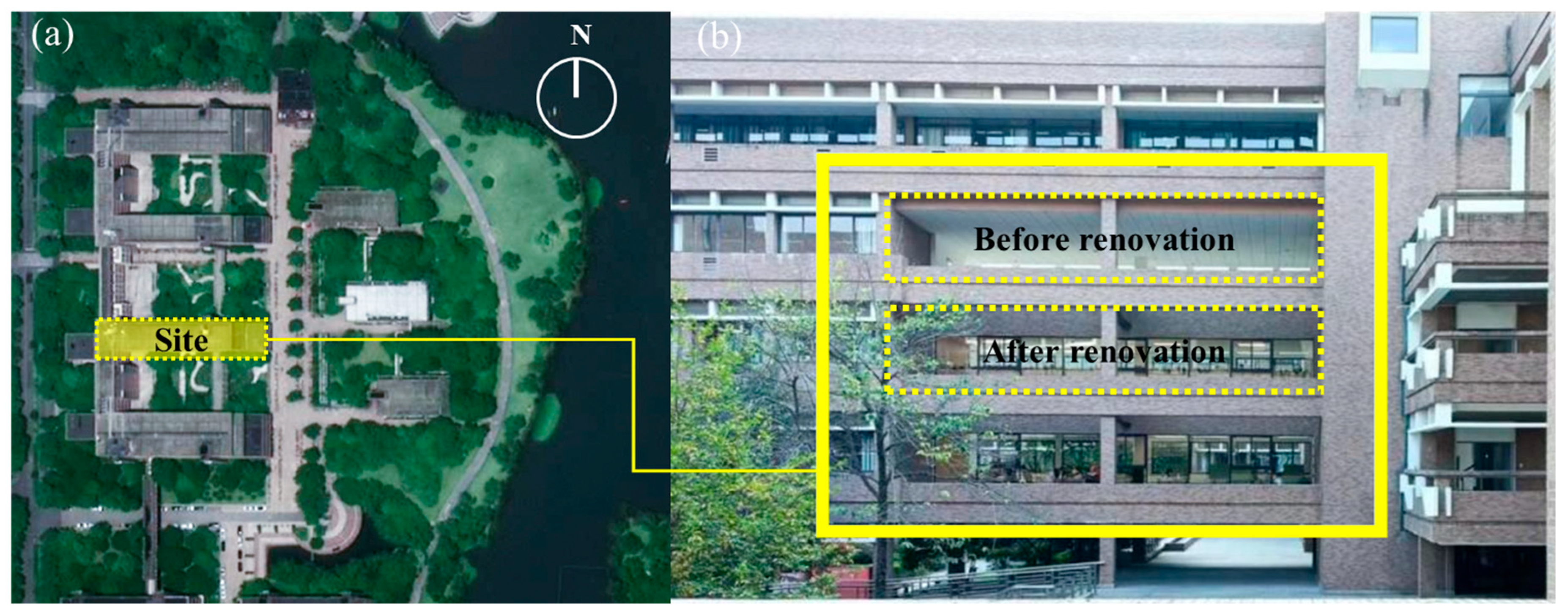
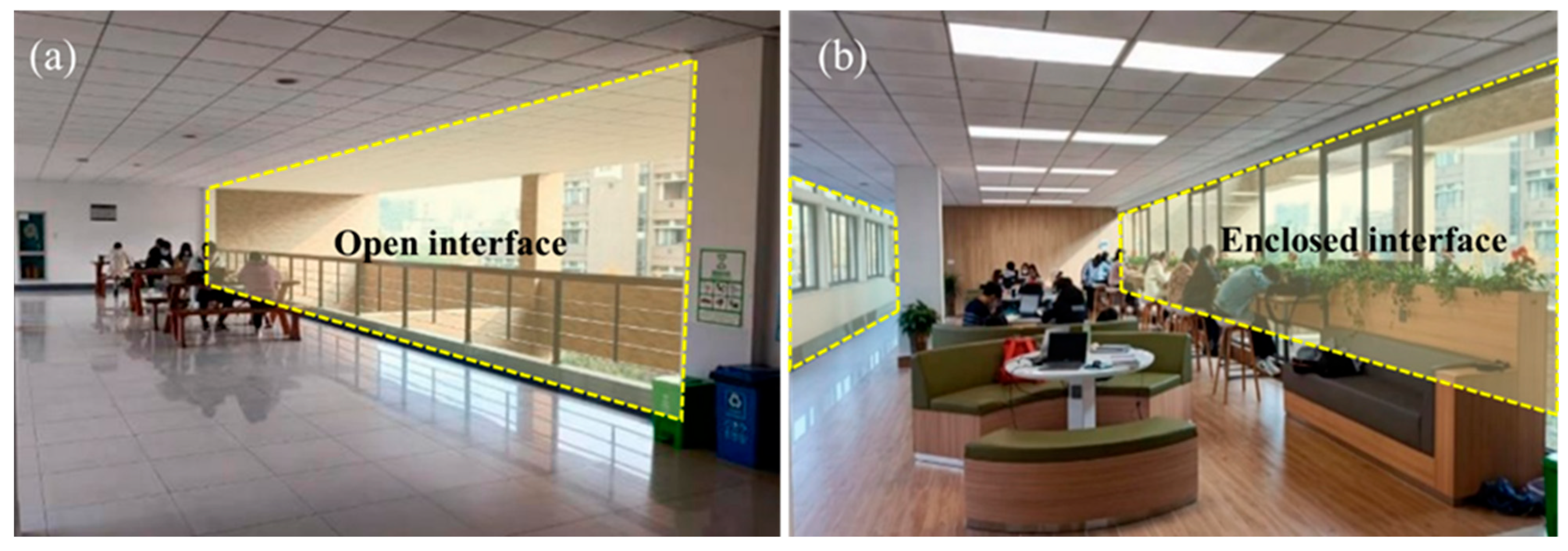
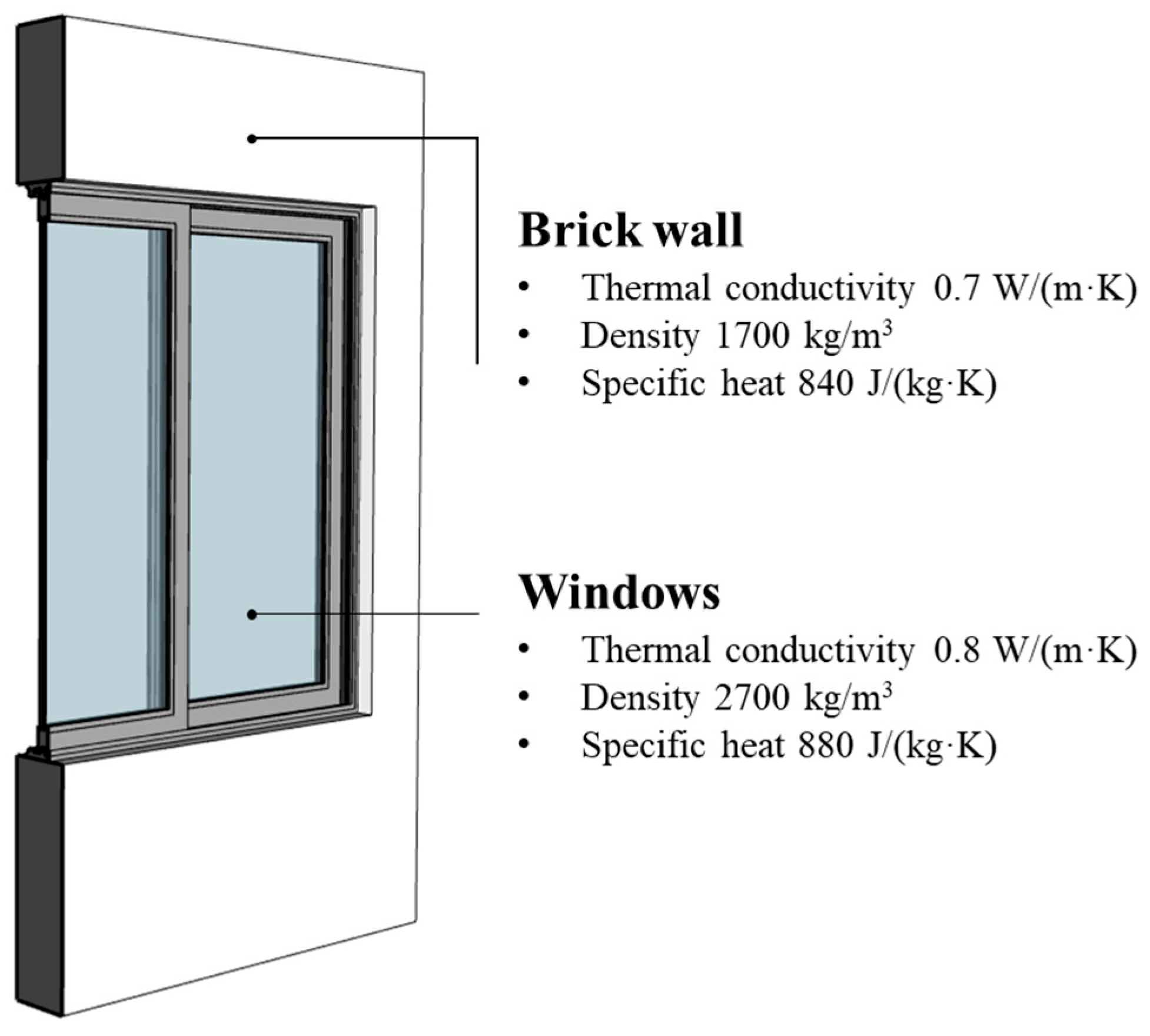
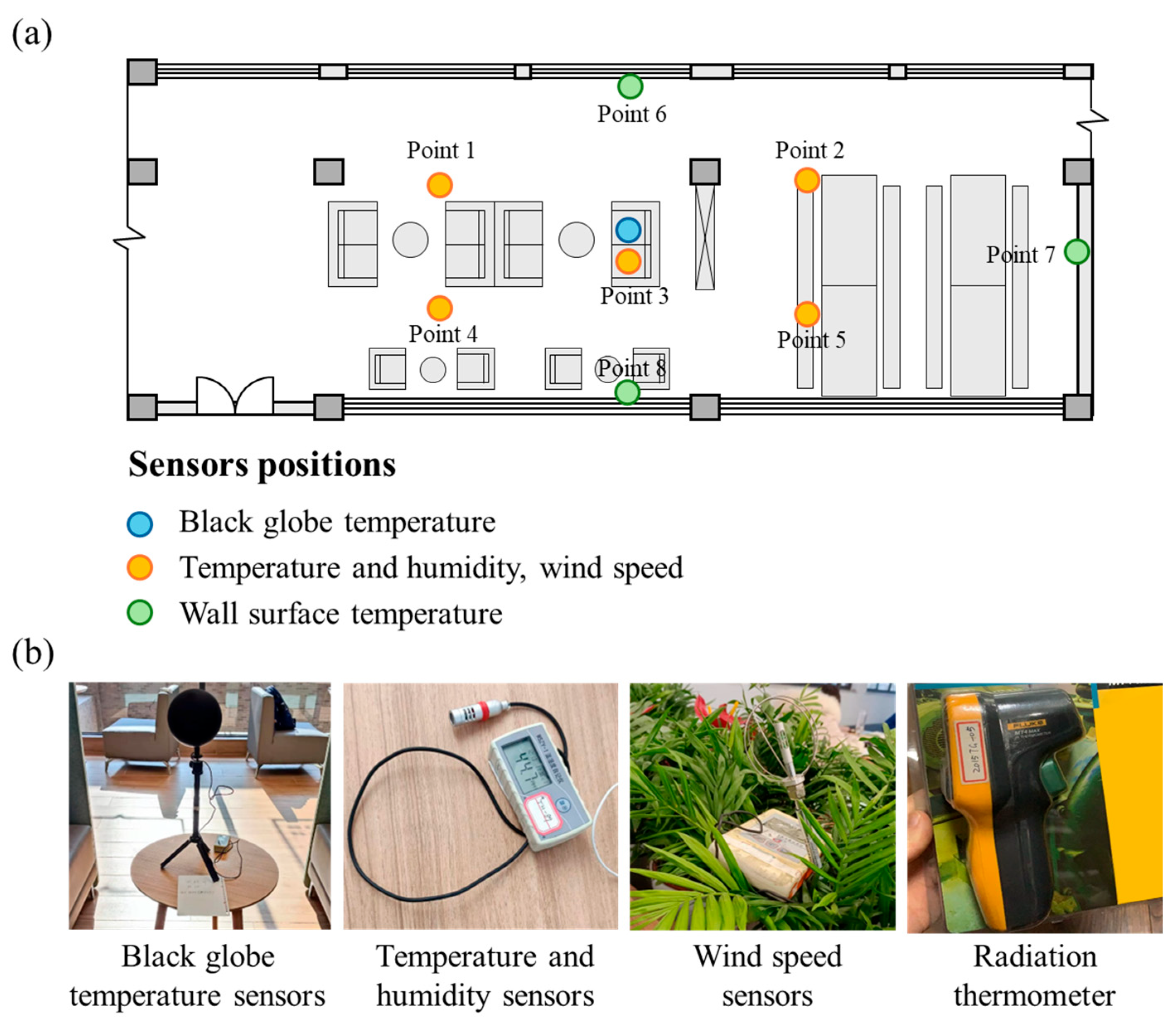

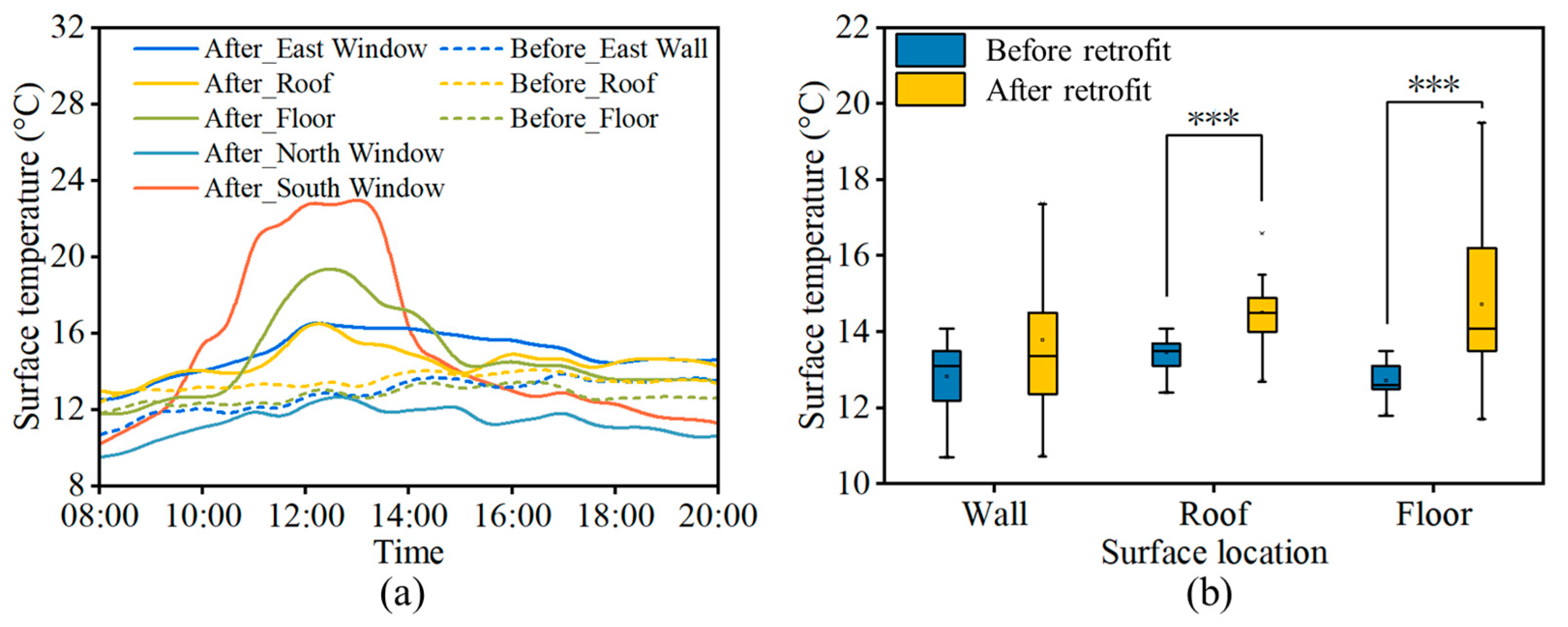
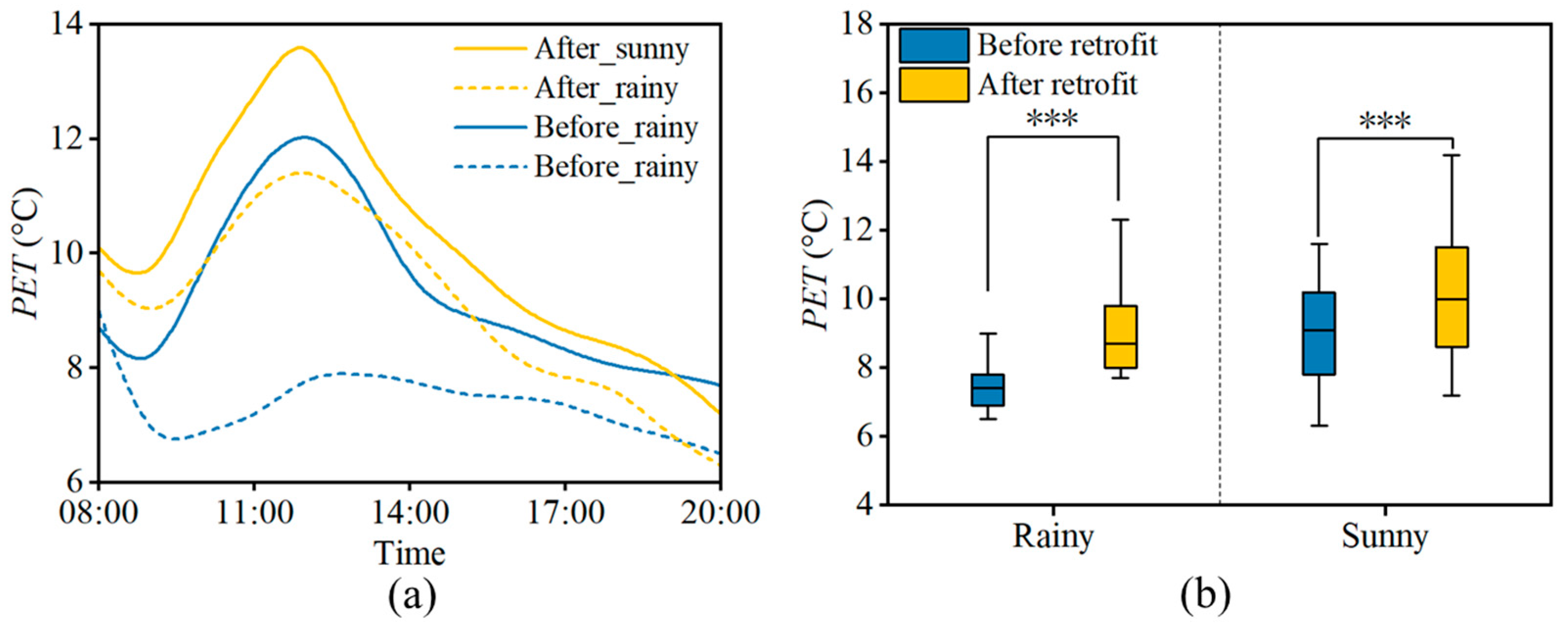
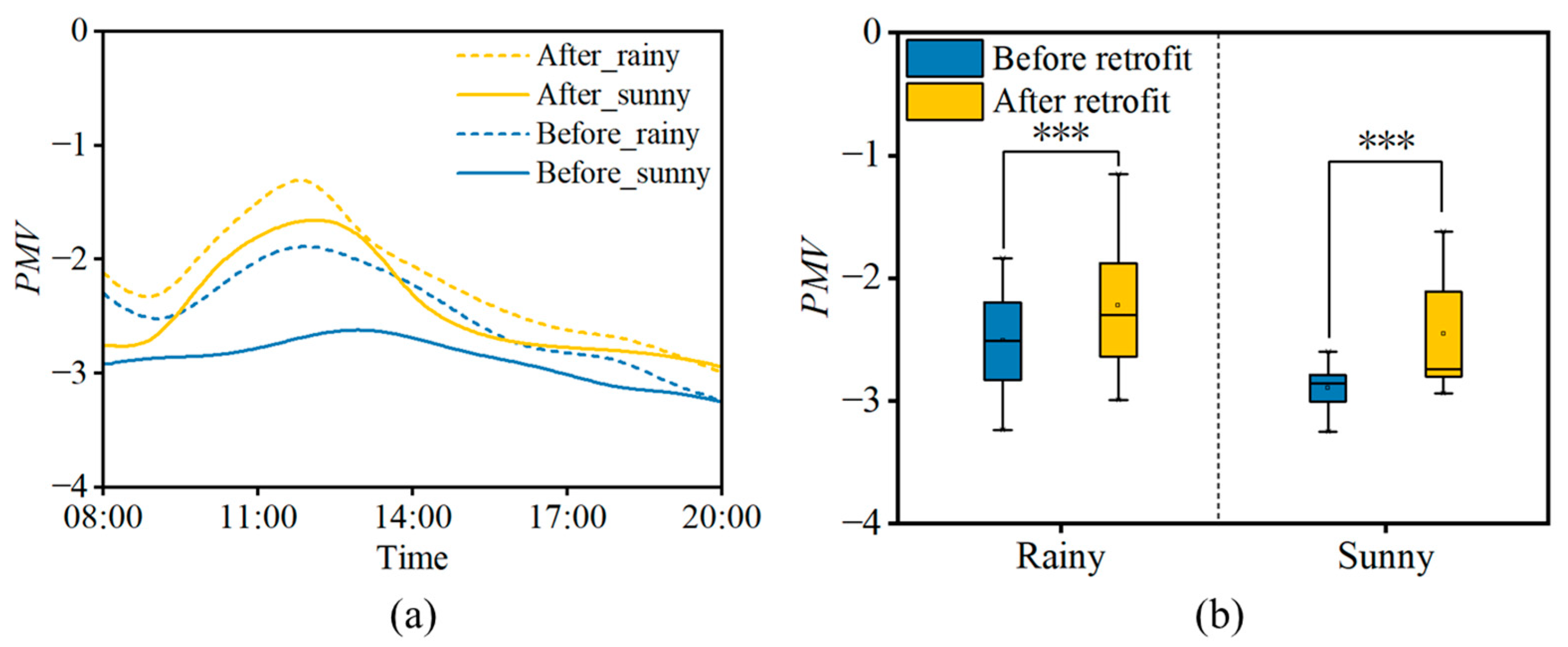
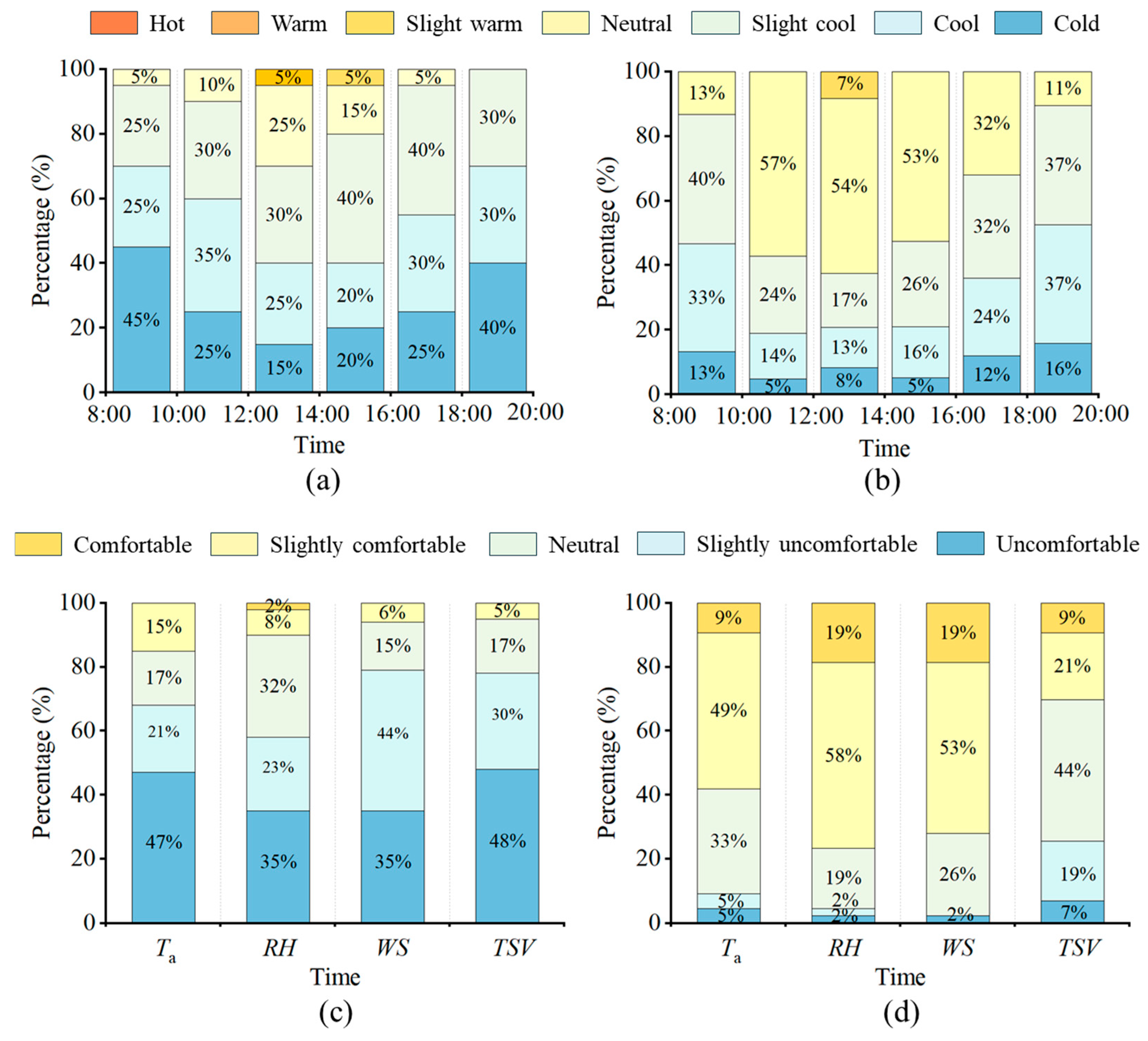
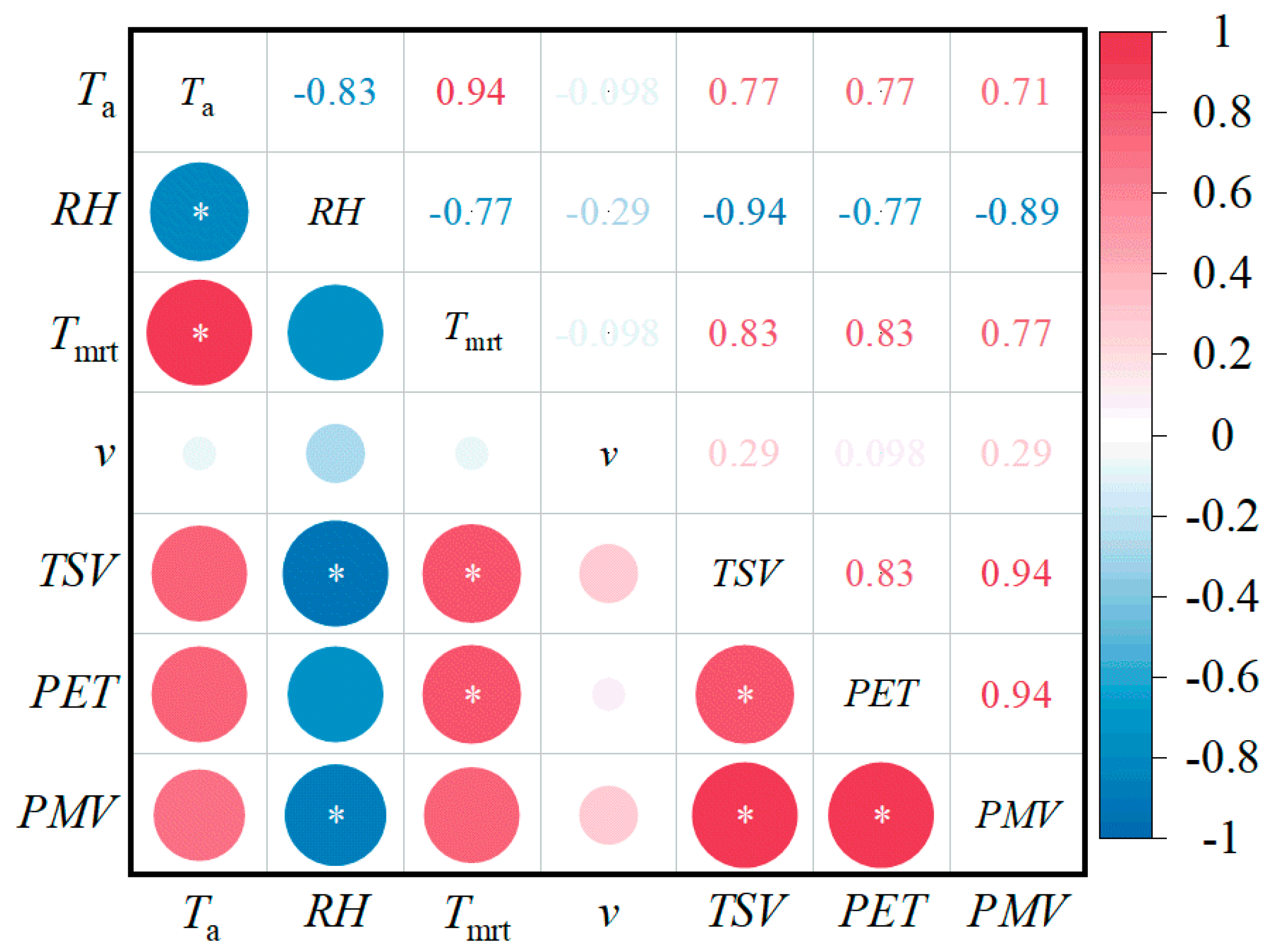
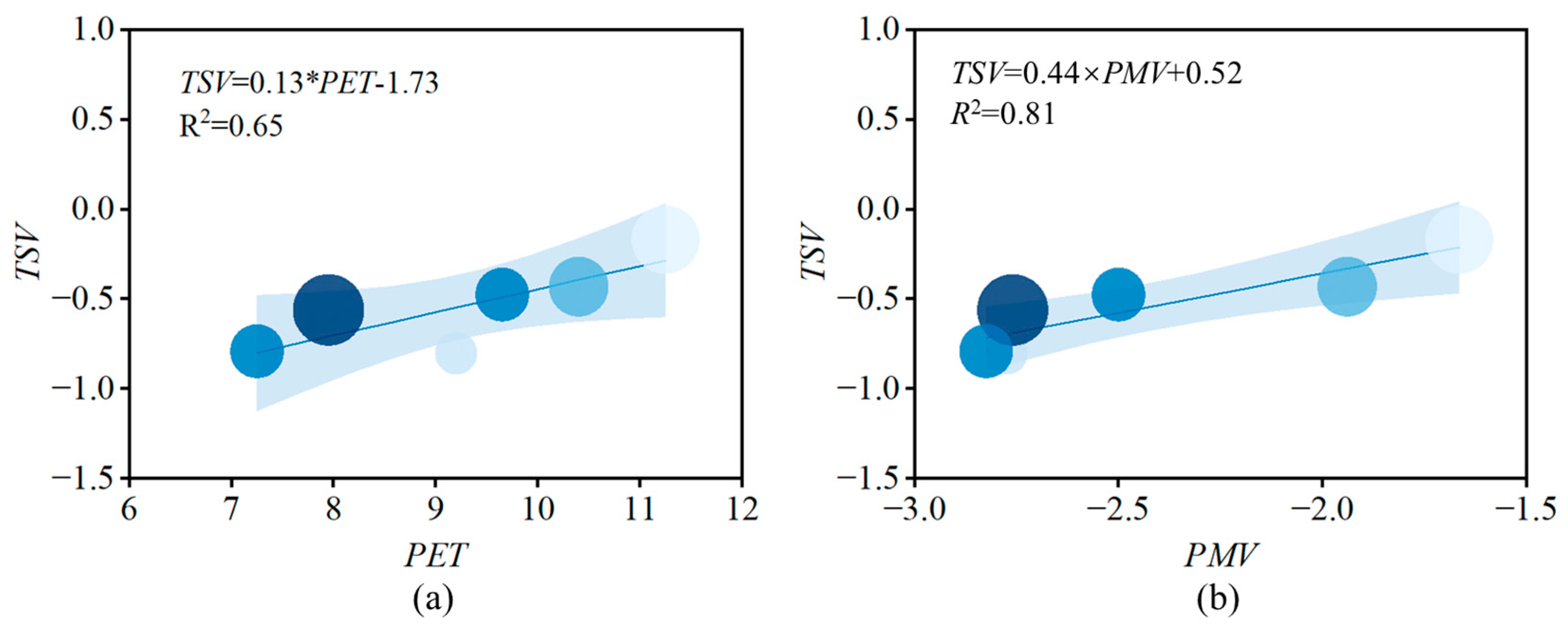
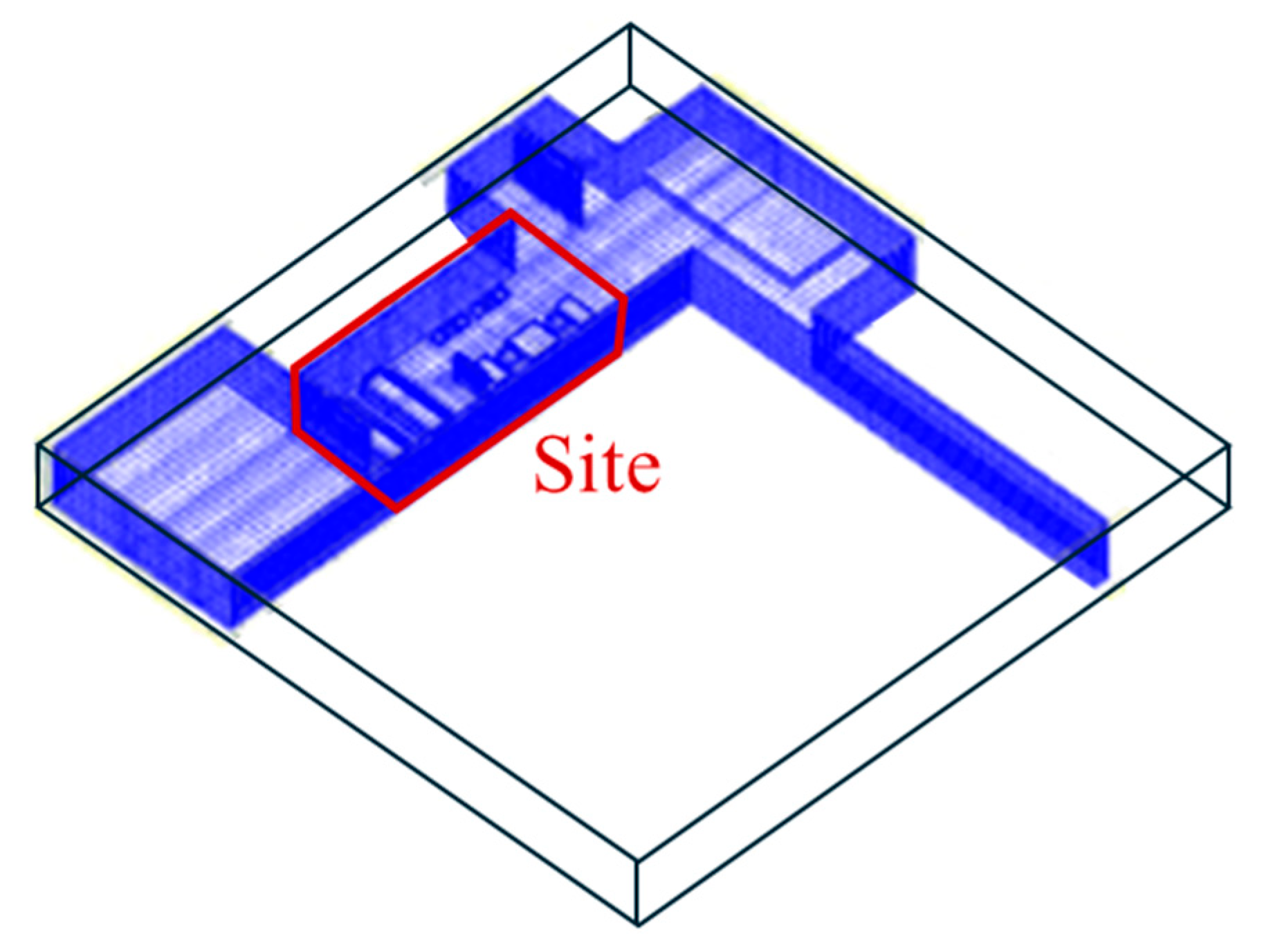
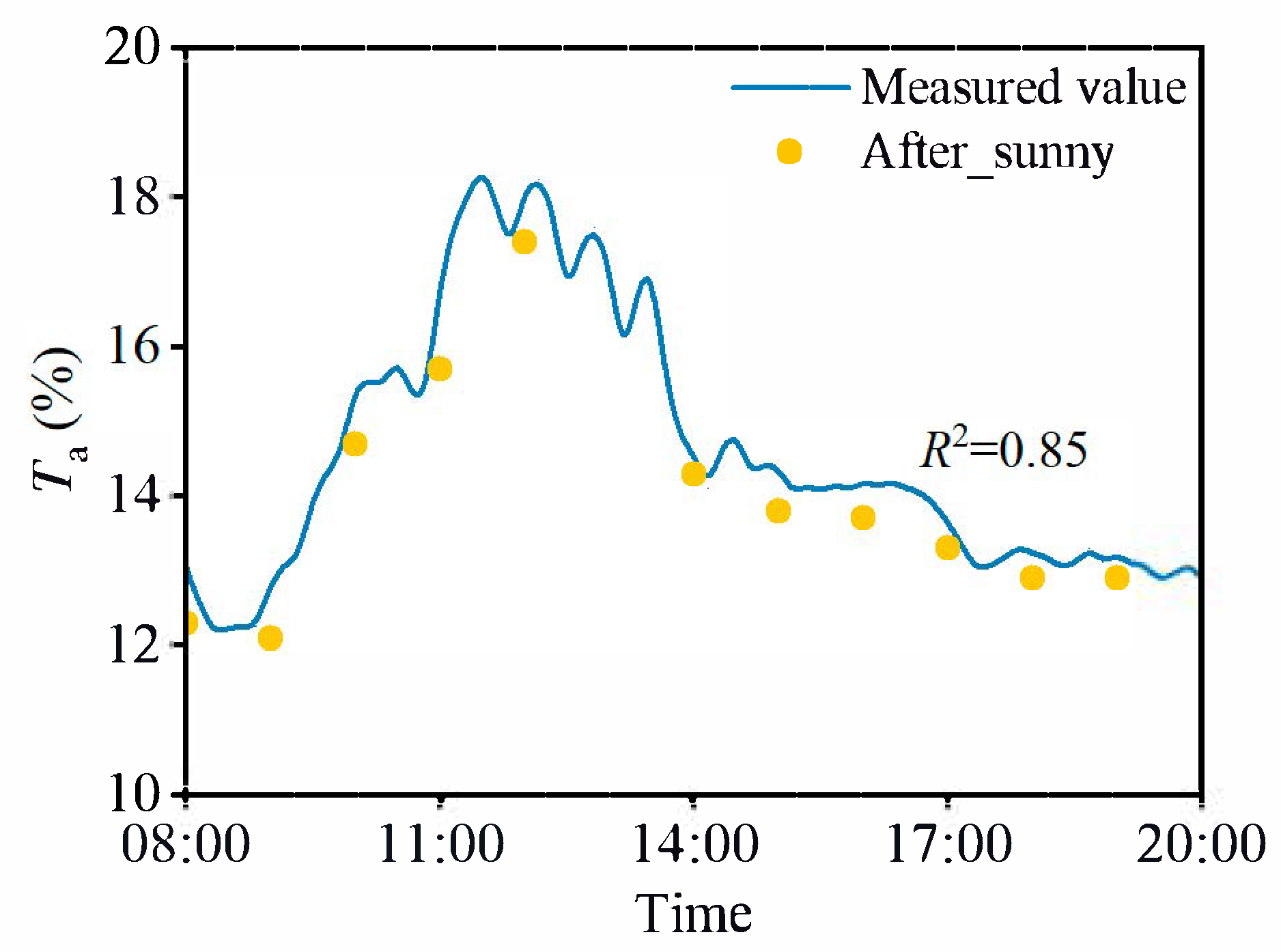
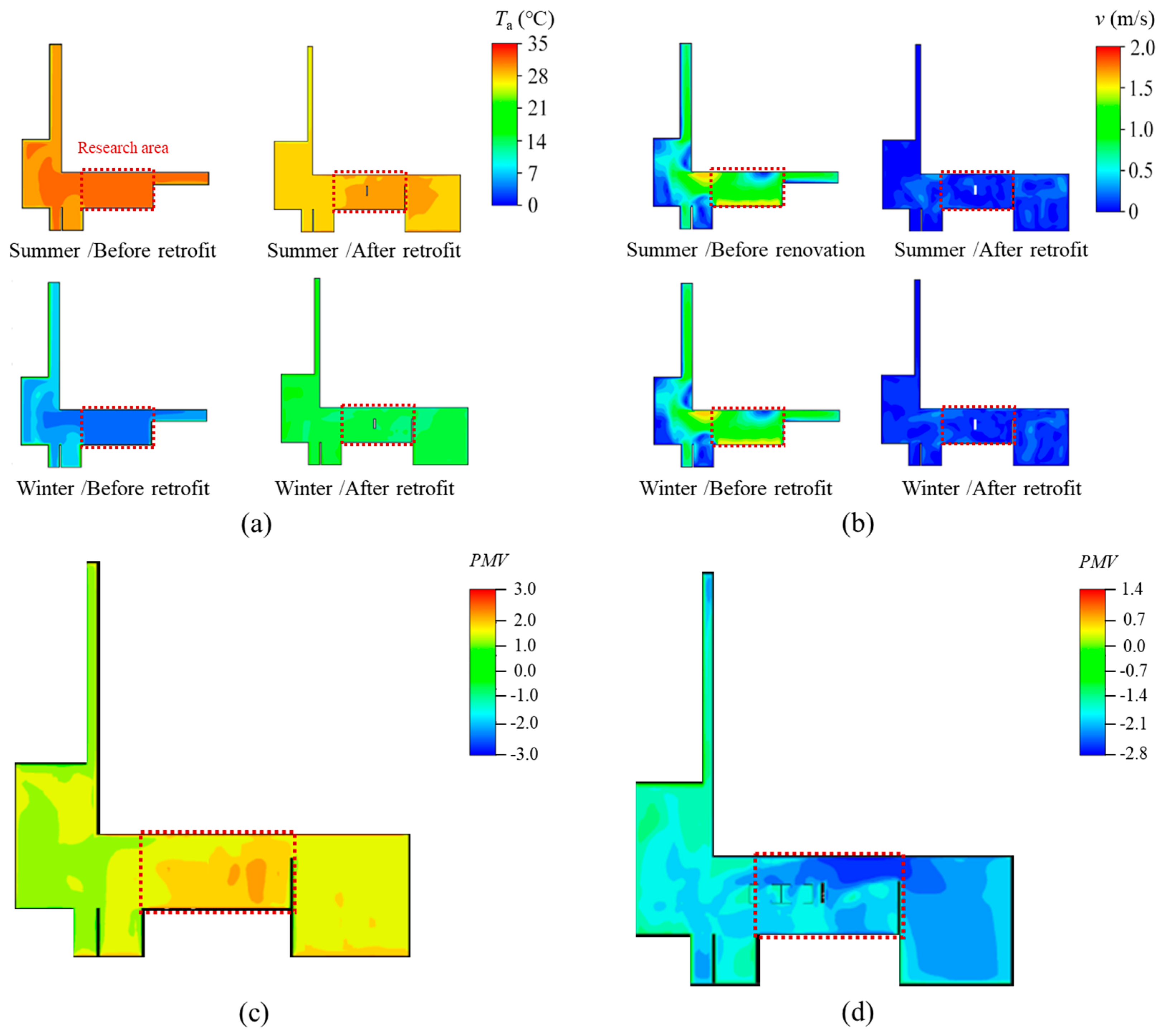
| Parameter | Instrument Name | Manufacturer | Model | Resolution | Measurement Range | |
|---|---|---|---|---|---|---|
| Temperature | Temperature and humidity logger | Tianjian Huayi Instrument Technology Co., Ltd. (Beijing, China) | WSZY-1 | 0.1 °C | −40~100 °C | |
| Humidity | 0.1% | 0~100% | ||||
| Wind speed | Anemometer | Tianjian Huayi Instrument Technology Co., Ltd. (Beijing, China) | WFWZY-1 | 0.01 m/s | 0.05~30 m/s | |
| Globe temperature | Globe thermometer | Tianjian Huayi Instrument Technology Co., Ltd. (Beijing, China) | HQZY-1 | 0.3 °C | −20~80 °C | |
| Radiant temperature | Infrared thermometer | Fluke Corporation (Everett, WA, USA) | MT4 MAX | 0.1 °C | −30~400 °C | |
Disclaimer/Publisher’s Note: The statements, opinions and data contained in all publications are solely those of the individual author(s) and contributor(s) and not of MDPI and/or the editor(s). MDPI and/or the editor(s) disclaim responsibility for any injury to people or property resulting from any ideas, methods, instructions or products referred to in the content. |
© 2025 by the authors. Licensee MDPI, Basel, Switzerland. This article is an open access article distributed under the terms and conditions of the Creative Commons Attribution (CC BY) license (https://creativecommons.org/licenses/by/4.0/).
Share and Cite
Ge, J.; Zhao, J.; Wu, Z.; Zhang, H. Investigation into the Impact of Enclosure Retrofit on Thermal Comfort in Semi-Open University Space. Buildings 2025, 15, 2883. https://doi.org/10.3390/buildings15162883
Ge J, Zhao J, Wu Z, Zhang H. Investigation into the Impact of Enclosure Retrofit on Thermal Comfort in Semi-Open University Space. Buildings. 2025; 15(16):2883. https://doi.org/10.3390/buildings15162883
Chicago/Turabian StyleGe, Jian, Jiahong Zhao, Ziyu Wu, and Honghu Zhang. 2025. "Investigation into the Impact of Enclosure Retrofit on Thermal Comfort in Semi-Open University Space" Buildings 15, no. 16: 2883. https://doi.org/10.3390/buildings15162883
APA StyleGe, J., Zhao, J., Wu, Z., & Zhang, H. (2025). Investigation into the Impact of Enclosure Retrofit on Thermal Comfort in Semi-Open University Space. Buildings, 15(16), 2883. https://doi.org/10.3390/buildings15162883





